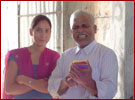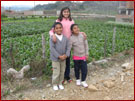|
Some statistics about women in Nepal
| Women |
Indicators |
| Life expectancy: females as a % of males, 2006 |
101 |
| Adult literacy rate: females as a % of males, 2000-2006* |
56 |
| Enrolment and attendance ratios: females as a % of males, net primary
school 2000-2006*, enrolled |
92 |
| Enrolment and attendance ratios: females as a % of males, net primary
school 2000-2006*, attending |
95 |
| Enrolment and attendance ratios: females as a % of males, net secondary
school 2000-2006*, enrolled |
- |
| Enrolment and attendance ratios: females as a % of males, net secondary
school 2000-2006*, attending |
83 |
| Contraceptive prevalence (%), 2000-2006* |
48 |
| Antenatal care coverage (%), 2000-2006* |
44 |
| Skilled attendant at delivery (%), 2000-2006* |
19 |
| Institutional deliveries (%), 2000-2006* |
18 |
| Maternal mortality ratio†, 2000-2006*, reported |
280 |
| Maternal mortality ratio†, 2005, adjusted |
830 |
| Maternal mortality ratio†, 2005, Lifetime risk of maternal death.
1 in: |
31 |
Definitions of the indicators
Life expectancy at birth - The number of years newborn children would
live if subject to the mortality risks prevailing for the cross-section
of population at the time of their birth.
Adult literacy rate - Percentage of persons aged 15 and over who can
read and write.
Gross enrolment ratios: females as % of males - Girls’ gross enrolment
ratio divided by that of boys, as a percentage. The gross enrolment ratio
is the number of children enrolled in a schooling level (primary or secondary),
regardless of age, divided by the population of the age group that officially
corresponds to that level.
Contraceptive prevalence - Percentage of women in union aged 15-49 years
currently using contraception.
Antenatal care - Percentage of women aged 15-49 years attended at least
once during pregnancy by skilled health personnel (doctors, nurses or
midwives).
Skilled attendant at delivery - Percentage of births attended by skilled
health personnel (doctors, nurses or midwives).
Maternal mortality ratio - Annual number of deaths of women from pregnancy-related
causes per 100,000 live births. This 'reported' column shows country reported
figures that are not adjusted for underreporting and misclassification.
Main data sources
Life expectancy - United Nations Population Division.
Adult literacy - United Nations Educational, Scientific and Cultural Organization
(UNESCO), including the Education for All 2000 Assessment.
School enrolment - UIS (UNESCO Institute for Statistics) and UNESCO ,
including the Education for All 2000 Assessment.
Contraceptive prevalence - Demographic and Health Surveys (DHS), Multiple
Indicator Cluster Surveys (MICS), United Nations Population Division and
UNICEF.
Antenatal care - DHS, Multiple MICS, World Health Organization (WHO),
UNICEF.
Skilled attendant at delivery - DHS, MICS, WHO and UNICEF.
Maternal mortality - WHO and UNICEF.
+ The maternal mortality data in the column headed ‘reported’
are those reported by national authorities. Periodically, UNICEF, WHO
and UNFPA evaluate these data and make adjustments to account for the
well-documented problems of underreporting and misclassification of maternal
deaths and to develop estimates for countries with no data. The column
with ‘adjusted’ estimates for the year 2000 reflects the most
recent of these reviews.
Notes
- Data not available.
x Indicates data that refer to years or periods other than those specified
in the column heading, differ from the standard definition, or refer to
only part of a country.
* Data refer to the most recent year available during the period specified
in the column heading.
We have used figures provided by UNICEF from their website
http://www.unicef.org/infobycountry/nepal_nepal_statistics.html
|





